Calm Computing+IR Sensor Final = SleepWalker Alarm
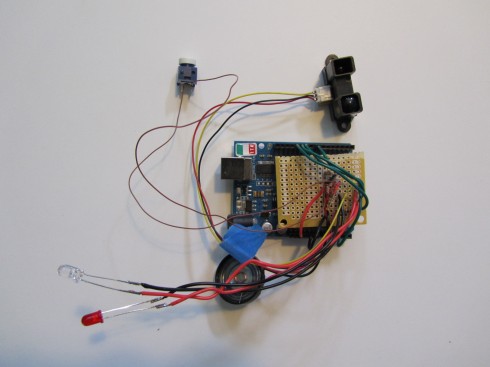

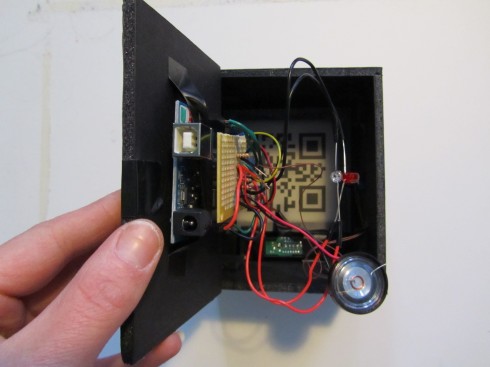
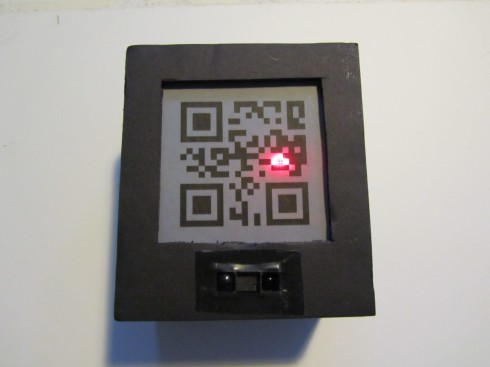
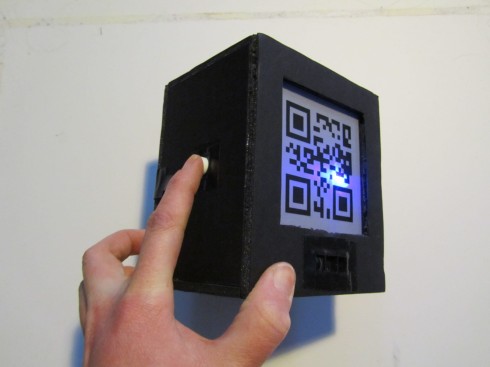
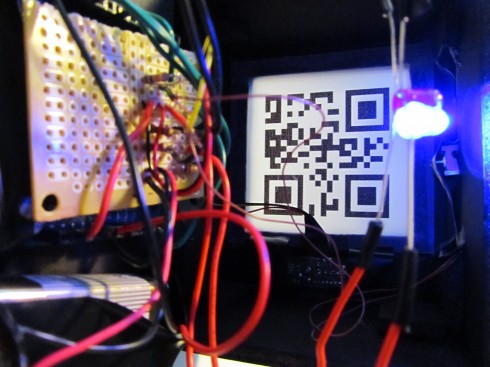
Code:
/*****************************************
* Liza Stark
* Physical Computing Final Project: Calm Computing
* May 3, 2011
*
* SleepWalker Alarm Clock
*
* This sketch uses a sharp IR sensor to detect motion
* when a person sits up in bed. The feedback comes in
* two stages: light and sound. When turned on, the dimLED
* acts as a nightlight to let the user know it is on. When the user sits up or moves within
* a range that is less than 60 cm, the dimLED goes off and the alarmLED turns on.
* If the user does not push the button within 15 seconds, the sound alarm goes off.
*
*
*
*
*
*****************************************/
int IRpin = 3; // analog pin for reading the IR sensor
int dimLED = 9; // Feedback LED to tell user it is on
int alarmLED = 10 ; // LED for first alarm
int speakerAlarm = 11; // Speaker alarm
int buttonPin = 7;
int buttonVal = 0;
int lastButtonVal = LOW;
int timer=0;
int lapse=15000;
int counter=0;
float volts;
float distance;
boolean alarm=false;
boolean restState = false;
boolean alarmOne = false; // This will test to see if
boolean alarmTwo = false;
boolean stayOff = false;
void setup() {
pinMode(dimLED, OUTPUT);
pinMode(alarmLED, OUTPUT);
pinMode(speakerAlarm, OUTPUT);
pinMode(buttonPin, INPUT);
Serial.begin(9600); // start the serial port
}
/**********************TIMER EXAMPLE************************/
//int timer=0;
//
//int lapse=2000;
//
//int counter=0;
//
//void setup(){
// Serial.begin(9600);
//}
//
//
//void loop(){
//
// if (millis()-timer>=lapse){
// counter++;
// timer=millis();
//
//
// }
//
// Serial.println(counter);
//}
/******************************************************************/
void loop() {
// Check IR and button values
volts = analogRead(IRpin)*0.0048828125; // value from sensor * (5/1024) - if running 3.3.volts then change 5 to 3.3
distance = 60*pow(volts, -1.0); // worked out from graph 65 = theretical distance / (1/Volts)S - luckylarry.co.uk
Serial.println(distance); // print the distance
delay(100);
buttonVal = digitalRead(buttonPin);
if(buttonVal){
Serial.println("pressed");
digitalWrite(dimLED,HIGH);
digitalWrite(alarmLED,LOW);
noTone(speakerAlarm);
digitalWrite(speakerAlarm,LOW);
alarm=false;
}
else{
if(distance < 60){
digitalWrite(alarmLED,HIGH);
digitalWrite(speakerAlarm,LOW);
digitalWrite(dimLED,LOW);
digitalWrite(speakerAlarm,LOW);
noTone(speakerAlarm);
alarm=true;
}
}
if(alarm){
if (millis()-timer>=lapse){
counter++;
timer=millis();
//Serial.println(counter);
Serial.println("speaker on");
digitalWrite(speakerAlarm,HIGH);
tone(speakerAlarm,10000);
}
}
}
Feb.10 Reading Responses
THE COMPUTER FOR THE 21ST CENTURY
Mark Weiser
This article is obviously way ahead of its time, very Vannevar Bushian for its insight into the evolution of technology’s integration into our lives. More interesting was his articulation and response to popular criticisms that would develop alongside the rise of ubiqutious computing, specifically the idea that more computer means less personal interaction. His distinction between virtual reality and ubiquitous computing caused the ground to tremble a bit beneath me, largely because I had never thought or been exposed to those two concepts as opposing. I instead grouped them together as most do as subsets of technology’s mediation on our lives. They definitely deserve distinction, more so for our psychological needs than anything else; a dialogue exploring the idea of enhancing vs. simulating reality needs to be addressed for a more general population.
He is very sober, practical, and successful in how he develops his argument favoring ubquitous computing. Weiser aligns it completely with the needs and desires of a particular business audience but also illustrates how from there it will continue to enhance other spheres of life, whether personal, familial, social, political, etc. His scenario and explanation makes it easy to imagine the possibilities in other realms: it is not just the ease of life he purports, but the heightening of interpersonal relationships. As a way tangential aside, it never ceases to fascinate me how personal relationships are used as a malleable soapbox in favor of or against tech, as if there was a golden age of human interaction to return to, or a better age of interaction just on the horizon. Call me an existentialist, but if anything, I think the role technology plays in mediating people today is much more aligned with our nature than in the past; there is more of a division between private and public space that at once reflects our very social, but also very personal, individual nature.
YOU ARE NOT A GADGET: A MANIFESTO
Jaron Lanier
Reading this article was an interesting evolution, oscillating from a stance as reactionary as his to a decided empathy for his position to a final more balanced appreciation for both sides. So with that caveat, I will begin my response by saying that it is still fascinating, probably more so now than when the “digital age” was cyberspace, to hear arguments in favor of technology’s dehumanization of individuals, culture, social structures, and self expression when we have seen its capacity for creativity and growth. this is not to say that there is not a dark side to technology, but i think that it reflects or even exacerbates already “problematic” human tendencies. For instance, I love the concept of the lock in – but this happens in any system and with any technology.
I also like his use of metaphors as a way to unpack his ideas. We impose them on computers and programs as a tool to understand them. And it is a two way street that makes the relationship between people and technology interesting; by conceiving of ourselves as something we are not, we grow from that comparison, from that otherization, even if lock-in does occur.
I suppose my main problem is that he relegates the argument to current technology and the speed with which it has exploded. Broadening the historical scope would make this argument much stronger for me and eliminate this as a contemporary “problem” of which it is not. But assuming its velocity is fixed is highly deterministic and leaves basically no room for human agency, which is ironic since I can only assume at this point this manifesto is a call to action. It seems like a great fallacy in the context of human development and assumes 8-bit apocalypse.
URBAN PROBES: ENCOUNTERING OUR EMERGING URBAN ATMOSPHERES
Eric Paulos & Tom Jenkins (2005)
Their approach to methodology is refreshing, if strenuous in some ways. In particular I liked their desire to focus on one element via the Urban Probe to gather data and observations in a particular scenario or interaction that might be lost when trying to focus on one element. Since there is not necessarily a desired outcome that might undermine the integrity of the observations, it is more meandering, more open to discovery. I like the subversion latent in this design, particularly the types of stimuli they hand the audience to gather more information about them, such as the postcards. One interesting theme throughout many of these readings are the methods of exploring new ecologies of tech interaction in physical space by actually engaging in that physical space. Since is forces us to reconceptualize our relationship with physical space and its digital counterpart, there is more of a focus on engaging directly with that space (bodystorming) vs. intentional outsider observation.
AUGMENTED SPACE
Lev Manovich
UPDATE: New response approach!
I have recently become more aware of distinguishing between certain reactions and perspectives that readings, projects, ideas, etc. engender upon my first encounter with them. Since they appear at odds upon first glance, I think it is helpful to respond to both. Cheers to discontinuity!
Response 1:
As AR grows, we will have to reconfigure our paradigm of surveillance, shifting it away from extremist conspiracy theories towards a more balanced, while still vigilant conception. One of the romanticisms most people still hold in general about technology is its ability to do anything and, to some degree, its infallibility. It is still a mythical, quasi-religious force that requires extreme devotion from its adherents, most of whom walk a fine line between psychosis and brilliance (Gillian Smith’s enthusiast taking a walk on the wild side); techie literacy has risen exponentially (and will continue to), but the learning curve is still steep for most (NYT article about the midwest).
We have to be willing to sacrifice our sense of security that is still a tacky residue from the past decades, and take a more active role in defining our hybrid spaces by participating in them. In some ways, I feel as though the rise of ubicomp and AR have greater potential to become greater democratizers than a signed piece of paper or equitably distributed funds. On the flip side, which we know so well from our science fiction, it has the potential for totalitarianism as well. It is almost a question of freedom: how much do you have to give in order to receive?
And upon further thought….
I think in general the “infiltration” or infusion of cellspace into everyday public and private spaces is ripening these environments for more reflective, poetic interactions because of the dialogue that will emerge from their juxtaposition. On some level, however conscious, we confront the duality between worlds and our role as perceptual mediator. We like it – it energizes our ideas of our environments as they currently exist and how they might exist in the future – especially since these spaces are by nature dynamically changing to reflect the movement of data within them. At one point, he distinguishes VR and AR in terms of their additive qualities to a particular situation: “we may add new information to our experience or we may add an altogether different experience”(253). This is sticky – either way you are creating a new experience within an environment. Once you add an element that reacts and interacts with other elements in that environment to create a holistic experience, there is a qualifiable change; if one element is reduced, the experience changes.
THIS would have been a great reading for design for this century.
Module 1: The Designed Object
FB_TP is an app combined with a toilet paper dispensing device that allows users to print their own or their friends’ statuses onto a role of toilet paper. When they print, users “flush” or delete the statuses they printed from their notifications page and their status automatically updates to display “Just Flushed!”
The Designed Object: FB_TP from Liza Stark on Vimeo.
This project arose from my desire to combine Winner’s concept of politicized objects with Csikzentmihalyi’s mediation on human’s need for objects in securing an external sense of order.
Transferring Csikzentmihalyi’s ideas of concrete objects into the digital realm provided a framework for working with Winner’s idea: to what extent has our participation in digital networks replaced physical objects in securing our sense of self? How are the power structures they produce in society different and similar to those produced by physical objects?
The full presentation is here.


